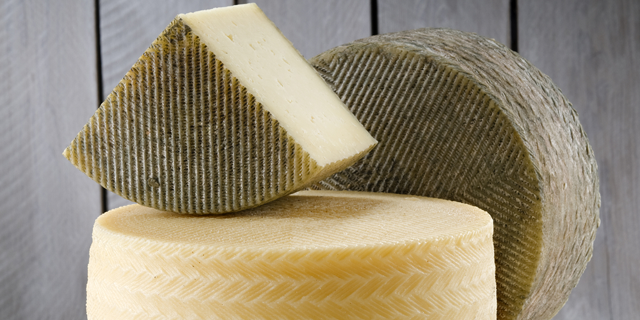Delicious sheep’s milk Spanish Manchego tastes wonderful all on its own but is equally heavenly when paired with Serrano ham or used to make huarache. But with an eight-ounce block of Manchego costing well over $8 these days, a frustrated foodie living on a tight budget would be forgiven for wondering “Could I make this at home for less?"
The answer is a confident “Yes.” Making hard cheese at home is definitely doable, but unlike making easier, low maintenance soft cheeses, the hard cheese making process requires a cheese press, in addition to specific cultures. And though culture and presses can be easily found and purchased from online cheese-making stores, when you start adding up the cost of the ingredients, it’s easy to begin questioning whether you’re really saving money by going the DIY route.
The savings are accrued gradually, by volume: What you’ll spend on ingredients will create a much larger block of Manchego than you could have gotten for the same price. If you make and eat a lot of hard cheese, you’ll quickly get a return on the money spent to acquire a cheese press. So perhaps it's time to make an investment and head for the kitchen.
Here's how, with some help from Cheese Forum.
What You'll Need
- 1 gallon whole cow’s milk (Though Manchego is traditionally made from sheep’s milk, cow's milk is easier to find.)
- 1/2 teaspoon calcium chloride
- 1/4 teaspoon mesophilic 2 culture
- 1/4 teaspoon thermophilic B culture
- 1/4 teaspoon lipase powder.
- rennet, diluted in 1/4 cup water, amount depending on package directions and your experience with that brand
- sea salt
- Olive oil
A note on cultures, check out these online shops to get you started: The Grape and Canary, The Cheesemaker, Leeners.
What to Do
1. In a stockpot, over medium heat, warm milk to 86 degrees.
2. In a seperate bowl, dissolve the calcium chloride in 1/4 cup of water.
3. In a seperate bowl, dissolve the mesophilic culture in 1/4 cup water and stir this mixture into the calcium chloride water mixture.
4. Add the thermophilic B culture to the calcium chloride/mesophilic culture mixture, stir to combine. This mixture is the culture water.
5. Add the culture water to the warmed milk, gently stir to combine, and cover. Let this mixture sit undisturbed for 45 minutes, to ripen.
6. While waiting for the mixture to ripen, dissolve the lipase powder in 1/4 cup water and let stand for 20 minutes. Add the lipase mixture to the cultured milk after it’s ripened, and gently stir for 1 minute to combine.
7. Dissolve the rennet in1/4 cup water, add to the cultured milk, and gently stir for 1 minute. Cover this mixture and let it sit undisturbed, keeping the mixture at 86 degrees.
8. When curd has formed (approximately 1 hour in), break the curds into small rice-size pieces by stirring it with a whisk.
9. Slowly heat the curds to 104 degrees, at a rate of 2 degrees every five minutes (total heating process will take about 45 minutes). Stir the curds occasionally and gently to prevent clumping.
10. Let the curds sit for 5 minutes. Pour off the excess whey.
11. Dampen and wring out a piece of cheesecloth big enough to double line the container of your cheese press.
12. Pour your curds into the cheese press container (lined with cloth) and press down with approximately 15 pounds of pressure for 15 minutes.
13. Remove the cheese from the press container, turn the cheese over, place it back in the container, and repeat press.
14. Repeat once more, flipping the cheese over and applying 15 pounds of pressure for 15 minutes.
15. Turn the cheese over, place back in container and press with 33 pounds of pressure for 6 hours.
16. Remove the cheese from the cheesecloth and place it in a salt brine for 6 hours at 50 to 55 degrees. Rotate the cheese every hour to promote even rind development.
17. Remove the cheese from the brine, pat it dry, and place it on a clean surface. Age the cheese for one week at 50 to 55 degrees and 80 to 85 percent humidity, rotating the cheese once per day. Any mold spots that appear can be scrubbed off with nylon-bristled produce scrub brush and vinegar.
18. When surface possesses a dry rind, rub the cheese with olive oil and let it age for at least 1 month. The outside will periodically need to be re-brushed with a thin coating of olive oil.
19. Serve.
A note on cheese presses: Cheese presses are notoriously expensive, with most models ranging anywhere from $100 to $300. Get creative by picking up a used or homemade machine on EBay (usually between $30 to $60) or make your own.


![Making Mealtime Matter with La Familia: Easy Sofrito [Video]](https://thelatinkitchen.com/wp-content/uploads/2015/10/sofrito-shutterstock__0-500x383.jpg)
![Easy Latin Smoothies: Goji Berry Smoothie [Video]](https://thelatinkitchen.com/wp-content/uploads/2015/12/goji_berry-shutterstock_-500x383.jpg)
















![Fun and Fast Recipes: Fiesta Cabbage Salad [Video]](https://thelatinkitchen.com/wp-content/uploads/2015/11/fiesta_cabbage_slaw-shutterstock_-500x383.jpg)









